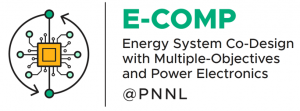
The E-COMP Initiative
The E-COMP Initiative
Advanced resilience and reliability in energy systems through innovative co-design with power electronics

Illustration by Cortland Johnson

The E-COMP Initiative
Advanced resilience and reliability in energy systems through innovative co-design with power electronics

Illustration by Cortland Johnson

The Energy System Co-Design with Multiple Objectives and Power Electronics (E-COMP) Initiative at Pacific Northwest National Laboratory (PNNL) is developing innovative capabilities to enable the multi-objective optimization of the design and operation of energy systems dominated by power electronics. These advancements are essential for modernizing the power grid to meet rising load demands while ensuring reliable, resilient, and affordable power delivery.
The widespread integration of power electronics-based devices introduces new challenges in maintaining the stability and reliability of interconnected energy systems. To address these challenges, E-COMP leverages a multi-disciplinary team of scientists and engineers equipped with cutting-edge computing and testing facilities, driving innovation and securing a competitive edge for the U.S. in this rapidly developing field.
As power systems incorporate increasing numbers of power electronics devices to control and convert electrical energy, crucial decisions about design and operation can help ensure system reliability, resilience, security, and affordability. Compounded by a rising number of distributed resources, decision-making around power system design and operation becomes even more pivotal. E-COMP integrates power system decision-making processes across three main technical areas:
By integrating these capabilities, E-COMP aims to further establish PNNL as a leader in energy system co-design, positioning the lab at the forefront of energy system modernization.
E-COMP validates its technical capabilities through use cases, which include:
By delivering validated co-design models, simulation tools, and actionable insights, E-COMP empowers energy stakeholders to build more resilient and efficient systems.
A multidisciplinary team of scientists, engineers, and professional staff from across the laboratory develop innovative solutions to meet the energy challenges of tomorrow.
Discover how PNNL can collaborate with you on technology development and deployment. Explore E-COMP's partnership flyer to learn about partnering mechanisms or connect directly with the E-COMP Initiative team lead to discuss opportunities with PNNL’s power electronics modeling and simulation experts.